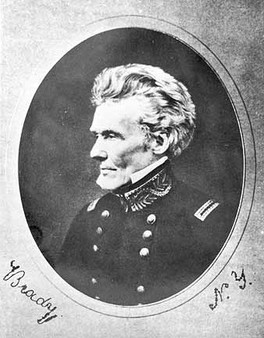Gaines Street
Introduction
Text-to-speech Audio
Images
General Edmund P. Gaines

Backstory and Context
Text-to-speech Audio
Edmund P. Gaines was born in Virginia in 1777. His father, James Gaines, distinguished himself as a militia commander during the American Revolution. Gaines enlisted in the United States Army at age twenty-two and quickly rose through the ranks becoming the commandant of a fort in the Mississippi Territory by 1807. During his time in the Mississippi Territory, he most famously ordered the arrest of former Vice President of the United States, Aaron Burr, on the charge of treason. Not long after this incident, Gaines chose to resign from the U.S. Army and pursue a legal career in order to meet some of his financial obligations. The Secretary of War reserved the right to recall Gaines should war breakout.
After the start of the War of 1812, Gaines returned to the army as a colonel. At first, he served under future President of the United States, William Henry Harrison. By early 1814, he had risen to the rank of Brigadier General and had taken command of American forces at Fort Erie. During a British bombardment of the fort, an shell exploded on the roof of Gaines’ command post wounding him severely. He had to leave his command to be treated for his injuries. After his convalescence, he was ordered south to New Orleans to assist Andrew Jackson, however he arrived after the hostilities had ended. After the war, he remained in the south to serve as one of two generals under Jackson’s command.
Between 1815 and 1821, Gaines was the commanding general on the frontier with Florida. During this time, Gaines grew concerned over the actions of a number of Creek “Red Sticks” in response to the enforcement of the Fort Jackson treaty. Many Native Americans disliked the terms of the treaty and did not abide by the ceding of land the treaty forced upon them. Much of the antagonism in the area seemed to be based out of “Negro Fort” on a bluff overlooking the Apalachicola River. The military considered this fort as the base of operations for raids into the southern frontier of the United States. The fort had been built by the British, but remained in Spanish territory, however Spanish authorities did not take any action regarding the inhabitants of the fort. The fort was a free Black community that included some fugitive slaves and Native Americans in its population. Gaines made a report to the War Department that implied the fort and its inhabitants had to be dealt with in some manner so the boundary with Florida would be safe and secure.
In order to justify a military action in Spanish sovereign territory, Andrew Jackson depicted the fort as a base of operations for a Native American and fugitive slave insurgency into the southern United States. The real reason was to return fugitive slaves to United States territory and enslave them once again. Gaines set up a base of operations in Georgia approximately 50 miles north of the border with Florida. In addition to American army and navy personnel, Gaines also had Creek allies join the attack on Negro Fort. Over the course of several week in July 1816, Gaines’ forces of Creeks, U.S. Army, and U.S. Navy personnel skirmished and fought with the defenders of Negro Fort. The battle culminated on July 17 when a gunboat fired a volley of cannon fire into the fort and one of the shells exploded in the fort’s gunpowder magazine setting off a massive explosion. The exact death toll is not precise, however estimates range as high as three hundred men, women, and children killed with only a handful of survivors.
Eight years later during the Florida legislative session of 1824, Territorial Governor William Pope DuVal laid out his proposal for Tallahassee’s design. Part of that design was the naming of many of the core streets within several blocks of what he called Capitol Square. One of those streets was Gaines Street named for Edmund P. Gaines to honor his military service to the area. Gaines spent the rest of his military career primarily in the west. He led troops during the Black Hawk War of 1832 and was commander of a military district in the southwest in 1836. At the beginning of the Mexican-American War, Gaines was commanding the Army’s Western Division and remained in that position until his death in 1849.
Sources
1.Clavin, Matthew J. The Battle of Negro Fort. New York: New York University Press, 2019.
2.Edmund Pendleton Gaines Papers, GA18, Box Number, Folder Number, Special Collections, The University of Texas at Arlington Libraries
3.Edmund P. and Myra C. Gaines Collection, William L. Clements Library, The University of Michigan
4.Groene, Bertram, Ante-Bellum Tallahassee (Tallahassee, FL: Florida Heritage Foundation, 1971), p.19 https://ufdc.ufl.edu/FS00000017/00001/27j.
5.Knott House Museum. Know Your Neighborhood: Tallahassee Street Name Origins. Tallahassee, FL: Knott House Museum, 1997
6.Silver, James W. "Edmund Pendleton Gaines and Frontier Problems, 1801-1849." The Journal of Southern History 1, no. 3 (1935): 320-44. Accessed April 11, 2020. doi:10.2307/2191671.
By Mathew Brady - National Archives. Copy found at the Alachua County Library site, Public Domain, https://commons.wikimedia.org/w/index.php?curid=706956
